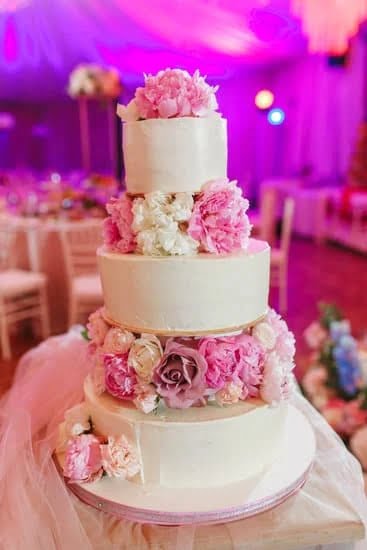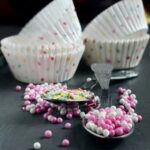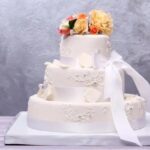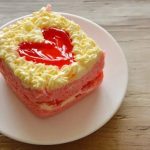When it comes to cake decorating in the UK, buttercream icing reigns supreme. This delectable frosting has gained immense popularity among bakers and home cooks alike for its versatility and delicious taste. Whether you’re a beginner or a seasoned pro, learning how to make the perfect buttercream icing is an essential skill that will elevate your cake creations to new heights.
Buttercream icing offers numerous benefits over other types of frosting. Its creamy texture allows for smooth application, making it ideal for creating intricate designs and decorations on cakes. The rich flavor adds a delightful sweetness that complements any cake flavor. Moreover, buttercream icing provides ample room for customization, allowing bakers to experiment with flavors and colors to suit their preferences.
In this comprehensive guide, we will delve into the world of buttercream icing, starting with the basics and progressing to advanced techniques. We will walk you through the step-by-step process of making buttercream icing from scratch and provide tips and tricks for achieving the perfect consistency and texture. Additionally, we will explore different variations of buttercream icing suited for various cake decorating techniques while providing recipes and instructions along the way.
So get ready to take your cake decorating game up a notch with our mouthwatering buttercream icing recipes and expert advice. From classic designs inspired by UK traditions to unique vegan or gluten-free options, there’s something here for every aspiring baker. Let’s dive into the enticing world of buttercream icing as we embark on a journey filled with creativity and culinary delight.
The Basics of Buttercream Icing
Buttercream icing is a popular choice for cake decorating in the UK due to its versatility, delicious taste, and smooth texture. Whether you’re a beginner or an experienced baker, mastering the basics of buttercream icing is essential for creating beautifully decorated cakes. In this comprehensive guide, we will walk you through the process of making buttercream icing from scratch and provide essential tips and tricks for achieving the perfect consistency and texture.
What is Buttercream Icing?
Buttercream icing is a type of frosting made primarily with butter, sugar, and flavorings. It is known for its creamy texture and ability to hold shapes when piped onto cakes. The main ingredients of buttercream icing include softened butter or margarine, confectioners’ sugar, vanilla extract (or other flavorings), and a small amount of milk or cream.
Making Buttercream Icing from Scratch
To make buttercream icing from scratch, start by beating the butter until creamy using an electric mixer. Gradually add confectioners’ sugar and continue beating until well combined and fluffy. Add vanilla extract (or other flavorings) to taste and mix well. If needed, add a small amount of milk or cream to achieve the desired consistency.
It’s important to note that different recipes may have slight variations in ingredient ratios or techniques. Therefore, it’s recommended to follow a specific recipe that suits your preferences and needs.
Tips for Perfect Consistency
Achieving the ideal consistency for your buttercream icing is crucial for easy spreading or piping onto your cakes. Here are some tips to help you achieve the perfect texture:
- Start with room temperature ingredients: This allows for easier mixing and smoother incorporation of ingredients.
- Gradually add sugar: Adding too much sugar at once can result in a grainy texture. Slowly incorporate the sugar while mixing until smooth.
- Adjust the milk/cream: If your buttercream icing is too thick, add a small amount of milk or cream to thin it out. Conversely, if it’s too runny, add more confectioners’ sugar to thicken it.
By following these guidelines and experimenting with different techniques and flavors, you’ll be well on your way to mastering the basics of buttercream icing for cake decorating in the UK.
Exploring Different Variations of Buttercream Icing for Various Cake Decorating Techniques
Buttercream icing is a versatile frosting that can be used for various cake decorating techniques in the UK. While traditional buttercream icing is made by beating together butter, powdered sugar, and flavorings, there are different variations of this frosting that can enhance the visual appeal and taste of your cakes. In this section, we will explore these different variations of buttercream icing and discuss when to use each one based on specific cake decorating techniques.
One popular variation of buttercream icing is American buttercream. This type of icing is made with butter, powdered sugar, and vanilla extract or other flavorings. It has a sweet and creamy texture that holds its shape well, making it suitable for piping intricate designs and creating borders. American buttercream is also sturdy enough to hold heavier decorations such as fondant or gum paste figures. Its simplicity makes it a great choice for beginners or when time is limited.
Another variation to consider is Swiss meringue buttercream. Unlike American buttercream which uses only softened butter, Swiss meringue buttercream incorporates egg whites as well. The result is a light and silky frosting that has a less pronounced sweetness compared to American buttercream. Swiss meringue buttercream is perfect for achieving smooth finishes on cakes and can also be used for creating delicate piped flowers or ruffles.
For those who prefer a richer and indulgent flavor profile, ganache buttercream may be the way to go. Ganache is traditionally made by combining chocolate with heavy cream but incorporating it into traditional American or Swiss meringue buttercream creates a luscious chocolatey finish. This type of buttercream works well for covering cakes entirely or as a filling between layers.
Each variation of buttercream icing brings its own unique qualities to cake decoration in the UK. By understanding their differences and characteristics, bakers can choose the most appropriate type based on their desired outcome and decorating needs. Experimenting with these variations will open up a world of possibilities for creating stunning and delicious cakes.
Achieving the Ideal Buttercream Icing Consistency
When it comes to buttercream icing, achieving the ideal consistency is key for successful cake decorating. However, there are common mistakes and issues that can arise during the process. In this section, we will address these challenges and provide helpful tips and techniques for troubleshooting and correcting the consistency of your buttercream icing.
One common issue that bakers may encounter is graininess in their buttercream icing. This can be caused by improperly incorporating the powdered sugar or using too much liquid. To avoid this problem, it is important to sift the powdered sugar before adding it to the butter.
This helps break up any clumps and ensures a smooth texture. Additionally, gradually adding small amounts of liquid at a time while mixing on low speed can prevent over-saturating the icing, which can lead to graininess.
Another issue that often arises is runny buttercream icing. This can be frustrating when trying to achieve intricate designs or piped decorations. The consistency of your buttercream can be affected by temperature – if it’s too warm, it may become runny. To fix this problem, you can try placing your mixing bowl in the refrigerator or freezer for a few minutes to cool down the mixture. Alternatively, you can add more powdered sugar gradually until the desired consistency is reached.
It’s also important to consider potential mistakes that can occur during the process of making buttercream icing. One common mistake is overmixing the ingredients, which can lead to a thin and less stable icing. It’s recommended to mix only until all ingredients are fully incorporated to avoid overmixing.
By addressing these common issues and providing troubleshooting tips, you’ll increase your chances of achieving perfect buttercream icing consistency every time you decorate a cake. Don’t be discouraged if it takes a few attempts – practice makes perfect. With patience and attention to detail, you’ll be able to master the art of achieving the ideal buttercream consistency for all your cake decorating endeavors.
Tips and Tricks for Decorating Cakes with Buttercream Icing
When it comes to cake decorating, buttercream icing offers a wide range of possibilities for creating beautiful and delicious designs. In the UK, there are many traditional culinary traditions and aesthetics that can be incorporated into cake designs. Whether you’re looking to add a touch of elegance or capture the charm of British countryside, here are some tips and tricks for decorating cakes with buttercream icing inspired by the UK.
- Piping Technique: Piping is a versatile technique that can be used to create intricate designs such as lace patterns, borders, or even floral patterns. To achieve precise piping with buttercream icing, it’s important to have the right consistency. A stiffer consistency works best for detailed designs, while a softer consistency is perfect for creating smooth lines and borders.
- Rosettes and Swirls: Rosettes and swirls are classic buttercream decorations that can instantly elevate the look of your cake. To create rosettes, use a star-shaped piping tip and apply even pressure as you pipe spirals onto the cake. For swirls, use a round tip and pipe circular motions from the center of the cake outwards.
- Ombre Effects: Add depth and visual interest to your cake by incorporating ombre effects with buttercream icing. Start with one color of icing at the bottom and gradually transition to another color as you move towards the top of the cake. Use an offset spatula or a bench scraper to blend the colors together smoothly.
- Stenciling: Stenciling is a great way to add intricate patterns or personalized messages to your cake using buttercream icing. Place a stencil on top of your cake and use an offset spatula or palette knife to spread a thin layer of contrasting colored icing over it. Carefully lift off the stencil to reveal your design.
| Cake Design | Description |
|---|---|
| English Rose Garden Cake | A three-tiered cake adorned with buttercream roses and leaves to mimic an English rose garden. |
| Union Jack Cake | A patriotic cake featuring the iconic Union Jack design using red, white, and blue buttercream icing. |
| Victoria Sponge Cake | A classic British cake decorated with a layer of buttercream and fresh strawberries for a simple yet elegant finish. |
These are just a few examples of the limitless possibilities when it comes to decorating cakes with buttercream icing in the UK. Let your creativity flow and have fun experimenting with different designs and techniques. With practice and these helpful tips, you’ll be able to create stunning cakes that will impress both your taste buds and your guests.
Customizing Buttercream Icing for Special Dietary Needs
When it comes to cake decorating, it’s important to accommodate special dietary needs without compromising on taste and texture. In the UK, there is a growing demand for alternative buttercream icings that cater to those who follow a vegan or gluten-free lifestyle. Fortunately, with the right ingredients and techniques, you can create delicious vegan and gluten-free buttercream icings that are just as indulgent and satisfying as their traditional counterparts.
For those following a vegan diet, traditional buttercream icing poses a challenge due to its reliance on dairy products such as butter and milk. However, there are several plant-based alternatives that can be used to achieve a similar creamy texture and rich flavor. One popular option is using vegan spreads made from coconut oil or vegetable shortening instead of butter.
These spreads provide the necessary fat content while maintaining stability in the icing. Additionally, non-dairy milks like almond milk or soy milk can be used as substitutes for regular milk.
To make a vegan buttercream icing, start by creaming together your chosen vegan spread with powdered sugar until light and fluffy. This will help incorporate air into the mixture, resulting in a lighter texture.
You can then add in your preferred non-dairy milk gradually until you reach the desired consistency. It’s important to note that vegan buttercream may have a different flavor profile compared to traditional buttercream due to the absence of dairy but can still be just as delicious.
For those who require gluten-free options, it’s crucial to ensure that all ingredients used in the buttercream icing are free from gluten contamination. This means using gluten-free versions of ingredients such as powdered sugar or cornstarch if necessary. It’s also important to verify that any food colorings or flavorings added do not contain gluten-based additives.
When customizing buttercream icing for special dietary needs, experimentation is key. Don’t be afraid to try different vegan spreads, non-dairy milks, and gluten-free ingredients to find the combination that works best for you. Remember to taste and adjust the sweetness and flavor as needed, adding a pinch of salt or a splash of vanilla extract to enhance the overall taste.
By offering vegan and gluten-free buttercream options, you can ensure that everyone can enjoy beautifully decorated cakes regardless of their dietary restrictions. With a little creativity and attention to detail, you can create buttercream icings that are not only visually stunning but also inclusive and delightful for all.
Taking It to the Next Level
Creating Intricate Floral Designs and Sugar Lace
For those looking to elevate their cake decorating skills to a professional level, mastering intricate floral designs and sugar lace with buttercream icing is a must. These techniques add a touch of elegance and finesse to any cake.
To create intricate floral designs, start by piping small dots of colored buttercream icing onto the cake in a cluster formation. Then, using a petal tip nozzle, gently press the tip against the base of each dot and pull upward to create delicate petals. Repeat this process until you have created an entire flower or a bouquet of flowers. Remember to vary the pressure on the piping bag to create different-sized petals for a realistic effect.
Sugar lace is another advanced technique that can truly transform your cake design. First, prepare a sugar lace mixture made from ingredients such as confectioners’ sugar, water, and cornstarch. Spread the mixture onto silicone lace molds or pre-drawn lace patterns on parchment paper. Allow it to dry completely before gently peeling it off the mold or paper. Carefully place the sugar lace onto your cake, using extra buttercream icing as an adhesive if necessary.
Showcasing Advanced Piping Techniques
Advanced piping techniques can take your buttercream icing decorations to new heights of sophistication and complexity. Two notable techniques are creating buttercream flowers and elaborate borders.
Buttercream flowers involve using various nozzles to pipe flowers directly onto the cake surface or onto wax paper for later placement. From roses to daisies, there are endless possibilities when it comes to creating lifelike flowers with buttercream icing. Experiment with different nozzles and colors to achieve stunning floral arrangements.
Elaborate borders can bring an air of grandeur and intricacy to your cake design. These borders often feature piped scrollwork, lattices, or intricate patterns that encircle the cake’s edges. Practice piping consistent lines and shapes to achieve a polished and professional look.
Additional Tools and Resources
As you delve into advanced buttercream techniques, having the right tools and resources can greatly enhance your cake decorating abilities. Consider investing in specialized piping tips, such as petal tips for flowers or border tips for intricate borders. These tips are designed to create specific shapes and textures that can take your designs to the next level.
Additionally, there are numerous online tutorials, courses, and even workshops available for those looking to further develop their buttercream decorating skills. Engaging with the cake decorating community by joining forums or attending local meetups can provide invaluable support, inspiration, and feedback for your journey into advanced buttercream techniques.
Remember to practice patience and persistence when mastering these advanced techniques. It may take some time to perfect the intricate details but with practice, dedication, and a love for creativity, you’ll soon be creating show-stopping cakes that will impress anyone who sees them.
Frequently Asked Questions (FAQs) About Buttercream Icing Recipe for Cake Decorating in the UK
As you delve into the world of buttercream icing and cake decorating in the UK, you may come across some questions or concerns. In this section, we will address some frequently asked questions to help you navigate your buttercream journey with confidence.
- Q: Can I make buttercream icing ahead of time?
- A: Yes, you can make buttercream icing ahead of time. However, keep in mind that buttercream tends to stiffen when refrigerated. When ready to use the chilled buttercream, allow it to come to room temperature and give it a quick whip before piping or spreading onto your cakes.
- Q: How long can I store leftover buttercream icing?
- A: Stored properly in an airtight container or sealed bag, buttercream icing can be refrigerated for up to two weeks. If you plan on using it beyond that timeframe, it is recommended to freeze it. Thaw frozen buttercream overnight in the refrigerator and bring it back to room temperature before using.
- Q: Is there a way to achieve a pure white buttercream?
- A: Butter naturally has a yellow tint, which can affect the whiteness of the final product. To achieve a whiter shade of buttercream, you can opt for using clear imitation vanilla extract or white gel food coloring. Avoid using liquid food coloring as it may thin out the consistency of your frosting.
- Q: How do I prevent air bubbles from forming in my piped designs?
- A: Air bubbles commonly occur when piping designs with buttercream icing. To reduce their occurrence, gently tap the filled piping bag against a hard surface to release any trapped air before piping. Additionally, starting with a smooth and ovoid consistency of buttercream can also help minimize air bubbles.
- Q: Can I color buttercream icing using natural ingredients?
- A: Yes, you can use natural ingredients to achieve various shades in your buttercream icing. For example, you can use beetroot powder for shades of pink or purple, matcha powder for green, and cocoa powder for brown tones. Experiment with small amounts and adjust the quantity as needed to achieve your desired colors.
These FAQs should help address some common concerns when it comes to working with buttercream icing for cake decorating in the UK. Remember that practice makes perfect, and don’t be afraid to experiment and personalize your creations. Enjoy the process of exploring different techniques and designs with this versatile frosting.
Conclusion
In conclusion, buttercream icing is undeniably the perfect choice for cake decorating in the UK. Its popularity stems from its versatility, taste, and ease of use. Throughout this article, we have explored the basics of buttercream icing, different variations for various cake decorating techniques, troubleshooting and common mistakes to avoid, tips and tricks for decorating cakes with buttercream icing inspired by UK designs, options for special dietary needs, advanced techniques for professional cake decorating, and frequently asked questions.
By following the step-by-step process outlined in this article and utilizing the provided recipes and instructions, you can elevate your cake decorating game with perfectly crafted buttercream icing. Whether you are a beginner or an experienced baker, there is something here for everyone. From simple piping to elaborate floral designs and sugar lace creations, buttercream icing allows you to unleash your creativity and bring your cake designs to life.
As you embark on your cake decorating journey using buttercream icing in the UK, remember to experiment and have fun. Don’t be afraid to try new techniques or incorporate your own unique touch. The possibilities are endless when it comes to creating stunning cakes with buttercream icing.
To further enhance your skills and knowledge in working with buttercream icing, there are plenty of additional resources available. Online tutorials, forums, and classes can provide valuable insights from professionals in the industry. Additionally, practicing regularly will help refine your technique and create signature designs that will impress friends, family, or even potential clients.
So go ahead and start experimenting with perfectly crafted buttercream icing today. Elevate your cake decorating game in the UK by mastering this versatile medium that allows you to turn ordinary cakes into extraordinary works of art.
Frequently Asked Questions
What is the best buttercream to use for decorating cakes?
The best buttercream to use for decorating cakes is often considered to be Swiss meringue buttercream. This type of buttercream is made by whisking egg whites and sugar together over gentle heat until the sugar dissolves, and then beating in softened butter.
Swiss meringue buttercream has a silky smooth texture, making it perfect for creating crisp edges and intricate designs on cakes. It also holds up well in warmer temperatures and has a light, creamy taste that complements a variety of cake flavors.
What is the secret to buttercream frosting?
The secret to buttercream frosting lies in achieving the perfect balance between sweetness, flavor, and consistency. One important aspect is using high-quality ingredients, including unsalted butter that is at room temperature, real vanilla extract or other flavorings, and sifted powdered sugar. The correct ratio of ingredients is crucial for obtaining a smooth consistency that is easy to work with yet holds its shape when piped or spread onto a cake.
Another secret is to beat the butter well before adding the powdered sugar, ensuring that any lumps are eliminated for a velvety texture. Lastly, patience and practice are key as mastering the art of buttercream frosting takes time.
What are the 4 types of buttercream frosting?
The four types of buttercream frosting commonly used are American buttercream, Italian meringue buttercream, Swiss meringue buttercream, and French buttercream. American buttercream is the simplest and most common type made with just butter, powdered sugar, vanilla extract, and milk or cream. It has a sweet flavor but can have a slightly grainy texture. Italian meringue buttercream involves pouring hot sugar syrup into whipped egg whites before adding softened butter which results in a light and airy frosting with great stability.
Swiss meringue buttercream uses heated egg whites beaten with sugar before incorporating softened butter resulting in a smoother texture compared to Italian meringue. Lastly, French Buttercream incorporates egg yolks cooked with hot syrup before adding softened butter, creating a rich and velvety frosting that is often used in more delicate pastries. Each type of buttercream has its own unique qualities and suitability for different cake decorating purposes.

Welcome to our cake decorating blog! My name is Destiny Flores, and I am the proud owner of a cake decorating business named Cake Karma. Our mission is to provide delicious, beautiful cakes for all occasions. We specialize in creating custom cakes that are tailored specifically to each customer’s individual needs and tastes.





